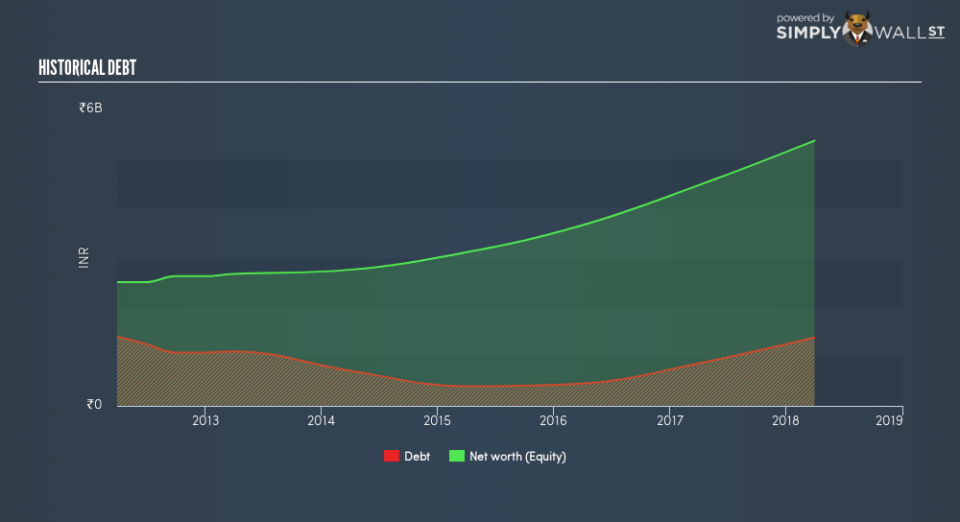Are Garware Technical Fibres Limited’s (NSE:GARFIBRES) Interest Costs Too High?

Garware Technical Fibres Limited (NSE:GARFIBRES) is a small-cap stock with a market capitalization of ₹26b. While investors primarily focus on the growth potential and competitive landscape of the small-cap companies, they end up ignoring a key aspect, which could be the biggest threat to its existence: its financial health. Why is it important? Evaluating financial health as part of your investment thesis is crucial, as mismanagement of capital can lead to bankruptcies, which occur at a higher rate for small-caps. I believe these basic checks tell most of the story you need to know. However, since I only look at basic financial figures, I suggest you dig deeper yourself into GARFIBRES here.
Does GARFIBRES produce enough cash relative to debt?
GARFIBRES’s debt levels surged from ₹861m to ₹1.4b over the last 12 months , which is mainly comprised of near term debt. With this rise in debt, the current cash and short-term investment levels stands at ₹229m , ready to deploy into the business. Additionally, GARFIBRES has generated cash from operations of ₹280m in the last twelve months, leading to an operating cash to total debt ratio of 20%, indicating that GARFIBRES’s operating cash is sufficient to cover its debt. This ratio can also be interpreted as a measure of efficiency as an alternative to return on assets. In GARFIBRES’s case, it is able to generate 0.2x cash from its debt capital.
Can GARFIBRES meet its short-term obligations with the cash in hand?
Looking at GARFIBRES’s ₹4.1b in current liabilities, it seems that the business has been able to meet these commitments with a current assets level of ₹4.9b, leading to a 1.2x current account ratio. Generally, for Luxury companies, this is a reasonable ratio since there’s a sufficient cash cushion without leaving too much capital idle or in low-earning investments.
Does GARFIBRES face the risk of succumbing to its debt-load?
With debt at 26% of equity, GARFIBRES may be thought of as appropriately levered. This range is considered safe as GARFIBRES is not taking on too much debt obligation, which can be restrictive and risky for equity-holders. We can check to see whether GARFIBRES is able to meet its debt obligations by looking at the net interest coverage ratio. A company generating earnings before interest and tax (EBIT) at least three times its net interest payments is considered financially sound. In GARFIBRES’s, case, the ratio of 75.72x suggests that interest is comfortably covered, which means that lenders may be inclined to lend more money to the company, as it is seen as safe in terms of payback.
Next Steps:
GARFIBRES’s debt level is appropriate for a company its size, and it is also able to generate sufficient cash flow coverage, meaning it has been able to put its debt in good use. Furthermore, the company will be able to pay all of its upcoming liabilities from its current short-term assets. This is only a rough assessment of financial health, and I’m sure GARFIBRES has company-specific issues impacting its capital structure decisions. You should continue to research Garware Technical Fibres to get a better picture of the stock by looking at:
Future Outlook: What are well-informed industry analysts predicting for GARFIBRES’s future growth? Take a look at our free research report of analyst consensus for GARFIBRES’s outlook.
Historical Performance: What has GARFIBRES’s returns been like over the past? Go into more detail in the past track record analysis and take a look at the free visual representations of our analysis for more clarity.
Other High-Performing Stocks: Are there other stocks that provide better prospects with proven track records? Explore our free list of these great stocks here.
To help readers see past the short term volatility of the financial market, we aim to bring you a long-term focused research analysis purely driven by fundamental data. Note that our analysis does not factor in the latest price-sensitive company announcements.
The author is an independent contributor and at the time of publication had no position in the stocks mentioned. For errors that warrant correction please contact the editor at editorial-team@simplywallst.com.


